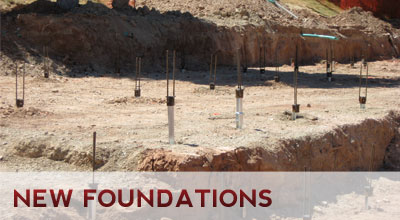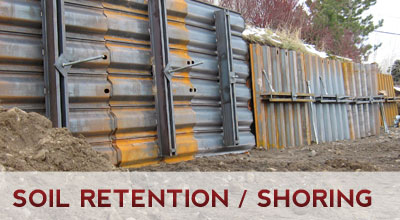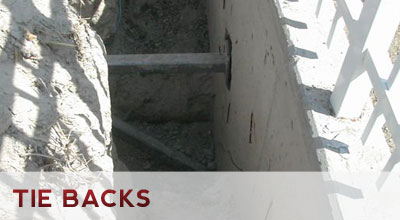
Our helical pier foundation systems are designed, tested, and proven for applications in expansive soils, high water tables, fill areas, and other areas where unstable soils require a deep foundation.
On new reinforced concrete grade beams, helical piers are usually placed every 8 to 15 feet depending on load.
A two man crew with a skid loader or backhoe can place over 50 helical piers ready for loading in less than one day. Helical piers rated for working loads of 10 to 25 tons are typical.

Helical pier foundation systems transfer the load to bearing plates [helices] that are located in stable soil. This system brings an economical solution to underpinning systems. Three advantages of this system are its speed of installation, its verifiable capacity, and its measurable construction [not sure what you mean by measurable….does that raise more ??’s or answer].
We supply pre-engineered systems for a variety of residential, commercial, and industrial foundation repairs.
Manufactured helical piers are rated up to 110,000 pounds each for underpinning. Special brackets are used to stabilize or lift foundations in distress.
After a complete inspection we determine the plan of repair or we have received the plan of repair from a qualified design group or individual, work can proceed. Remember, one of the best investments you can make is to do a helical pier test install or get a soil boring on your property. This will enable the designer to determine what type of anchor and to what depth it must go to reach stable soil. Usually the installer will excavate a hole at each anchor location wide enough and deep enough to place a bracket under the foundation. The leading section of the helical pier, with the proper number and size of helices, will be installed by a rotary machine. Extensions are added until the helices are at the proper depth and the predetermined torque load is achieved. At that point the underpinning bracket is attached to the foundataion, the load is transferred to the pier, and the building can be stabilized or lifted according to plan.

Shoring problems of all kinds can be solved with our unique panel system. Our 9′ x 7′ shoring panels are held in place with helical tiebacks placed in the center of the panel. The system is quick and easy to install, and is extremely versatile. The panels can be installed in projects with small limited spaces or used for large scale operations. Installation is done from the top down as excavation takes place, reducing overall construction time. There is no pounding or vibration than occurs during installation, and there is no need to wait for the system to cure like shot-crete shoring. The shoring panels can be a permanent solution or installed as needed for temporary construction projects.

A pre-engineered tieback system for earth retention simplifies the challenges for contractors. These tieback anchors are installed by rotating the anchors into the ground with common rotary drilling equipment.
Once the minimum depth is obtained the capacity can be determined by reading the installing torque and correlating it to the holding capacity ratio.
Capacities to 110,000 pounds per anchor are obtainable with this system. Proven on hundreds of applications, these cost effective tiebacks can be tested immediately. There is no need to wait for concrete to cure! This saves time and money as well as improves schedules.
Advantages for our tieback system include:
- Installed anchors can be proof-tested immediately — no waiting for grout to cure.
- Anchors can be installed in almost any weather, with conventional drilling equipment.
- No concrete trucks or grout pumps are required.
- Predictable holding strength in all soils.
- The success of the helical tieback system is based on decades of similar use of anchors by electric utilities.
- The proven reliability and engineered predictability of the system’s performance give you tiebacks that are positive, economical, and hassle-free.

Screw anchors can help prevent wall movement by holding the wall when soil swells and the resulting pressure pushes against the wall. Proven and building code accepted, these anchors will keep retaining walls from moving.
Basement walls can be repaired using helical screw anchors. This is accomplished by drilling a small hole for the anchor rod to pass through the basement wall, and then excavating a hole outside to place the bearing plate. A small high torque motor then rotates the screw anchor system into the soil. Once depth and predetermined torque is achieved, the anchor is terminated and a plate is mounted inside the basement wall to hold the wall in place. If the wall needs to be moved, then sufficient soil must be removed to allow the wall to move.
Our soil screw anchor saves time, money and is a proven answer to wall retention.

Our soil screw retention wall system reinforces the earth to construct gravity walls.
In this “soil nail” application, a screw anchor acts in a bearing mode as apposed to a grouted anchor, which relies on friction. Bearing plates are spaced along the entire length of the soil screw anchors. They are ready for immediate loading as soon as installed. This gives the soil screw retention wall system economic advantages.
Backhoes and skid-steer loaders can quickly rotate soil screw anchors into place. Anchor size and grid spacing are designed to local soil conditions and load requirements. A reinforced shotcrete veneer often is applied to the wall face.

In today’s society, with the awareness of our ecological balance and the concern over the environmentally sensitive wetlands, products that minimize construction impact are required.
Our instant foundation system is the answer. This helical pier, installed with mechanized hand-held equipment, is easily transported into these fragile areas. Thousands of these piers have been installed in the most sensitive areas such as wetlands, beach fronts, prairies, and historical sites.

Bridge foundations are a perfect application for helical piers. Conditions around locations where bridges are needed tend to be challenging, and are often undeveloped, wet, and difficult to access. Since helical piers can be installed using a boom arm from up to 40′ away access problems to installation locations are minimized. Equipment necessary for installing piers can also be managed from boats, allowing further flexibility. And because helical piers excel in providing support in wet and even underwater locations, bridges are an ideal application for their use.
Intermountain Helical Piers has installed helical piers for a variety of bridges for railroads, highways, golf courses, & environmentally sensitive walkways. See the case studies for more information.
